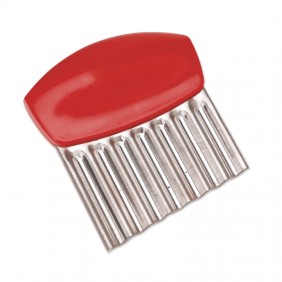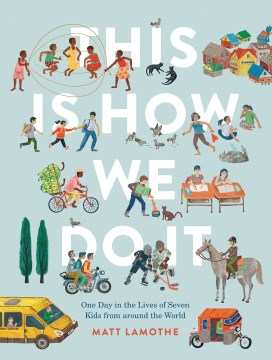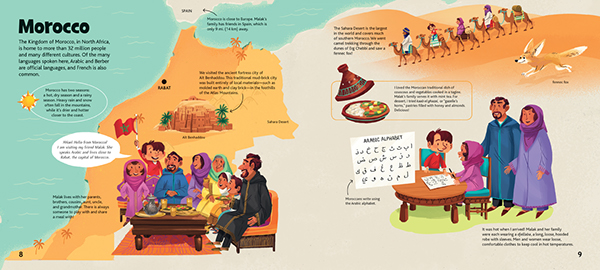
Title: Cooking Class
Author: Deanna F. Cook
Illustrator: Emily Baisley
Photographer: Julie Bidwell
Publisher: Storey Publishing
Publication Date: March 2015
Place of Publication: North Adams, MA
Age Range: Grades 3 - 12
Lexile Measure: NA
Awards: IACP Award Finalist
2015 “National Parenting Publications Awards” (NAPPA) Gold award winner
2015 Parents’ Choice Award Silver winner
2016 Mom’s Choice Award Gold winner
2015 NPR Great Reads
This engaging, child-friendly, generously illustrated cookbook begins with basic information about how the book is organized. The recipes are rated by difficulty with 1, 2, or 3 wooden spoons - the 1's do not require cooking or a sharp knife, while the 3's "involve cutting with sharp knives and using the oven and stovetop...If you are just learning to cook, work with an adult." The Table of Contents shows the chapters which are illustrated with children either preparing or eating a recipe from that chapter.


The lessons in the first chapter cover everything from a discussion of kitchen rules, which begins with washing your hands with warm water and soap to cleaning up afterward to setting the table and folding special napkins.

Each recipe includes step-by-step directions, and most have a box for "creative cooks" which offer additional ingredients and combinations, as shown below.

Following the recipe for a "toasty melt," (grilled cheese) is a recipe for a panini, with additional combinations for ingredients, for both, in the box for creative cooks.

Most of the recipes are fairly healthy and vegetables and fruits are featured prominently. Segues are made to show a visit to the orchard to pick apples for Easy-Peasy Applesauce, a discussion about having a garden or visiting the farmer's market, as well as suggestions for entertaining your family or community, such as a mix-and-match pizza party (shown below) and a sleepover party. Includes an Index.

This quote from a review by Family Fun magazine says it all, “An appealing blend of fun techniques (flowers made of fruit, anyone?) and practical recipes (omelets, apple crisp) make former FamilyFun editor Deanna F. Cook’s new book, Cooking Class, a must-have for any budding chef. The recipe variations and open-ended projects let kids take their culinary creativity to the next level.” — FamilyFun
The numbered and pictured steps make this title accessible to even non-readers, if they were experienced in the kitchen. Older and less experienced children, tweens, and even teens will still find this cookbook engaging because of the opportunity to be creative by using some of the additions and substitutions suggested. I think it would be a solid addition to every juvenile nonfiction collection.
Cooking Class would make a wonderful resource for creating a cooking program. Even if your library only allows you to serve prepackaged foods, many of these recipes are simply using those foods in different ways, such as the Lunch-on-a-Stick shown above. Quite a few of the recipes do not involve sharp knives or cooking either.

These delicious salads could be assembled with minimal cutting necessary. I have been successful using pumpkin carving knives and vegetable/fruit cutters like this one with younger children:

If your library has a MakerSpace with a kitchen, you could use literally cook your way through this book.
The addition of the presentation and serving information included in the book offer the opportunity to include Grace & Courtesy lessons along with cooking. For the final class, you could even host an event for the families of the chefs. You could even present the "chefs" with personalized graduation certificates, aprons, or their very own chef's hat.
One more library idea would be to tie the cooking programs to a children's garden. Even a few plants in pots would be a start. Who could resist tasting something that they had planted and nurtured from a tiny seed until they could finally harvest it themselves?
Companion Titles:

Title: The Young Chef: Recipes and Techniques for Kids Who Love to Cook
Author: Mark Ainsworth`
Illustrator: Joel Holland
Photographer: Phil Mansfield
Publisher: The Culinary Institute of America/Houghton Mifflin Hartcourt Publishing Company
Publication Date: April 5, 2016
Place of Publication: New York
Age Range: Grades 4 - 7
Lexile Measure: NA
Awards: NA
Brought to you by the famed Culinary Institute of America, this book is presented in two sections, Learning the Basics and Recipes. This title is meant for a slightly older audience. The basics include everything from food and chef safety, knife skills and techniques to cooking methods and nutrition. Recipes are laid out with steps, and include chef notes, photos, and explanations about ingredients. A fun note, "Think like a Chef," where experimentation with flavors and ingredients are encouraged accompanies many of the recipes. An index is included.
Here is an interview about this cookbook by Mark Ainsworth: http://www.food-management.com/k-12-schools/cooking-tips-cia-pro-kids-aren-t-dumb
I searched everywhere to find images from this book, but alas, I came up blank. Trust me, it is fully illustrated with color photography. I especially appreciated the diversity of chefs pictured in this title, including ethnicity, age, and gender.
The New York Times had this to say about this exemplery title, "Recipes in the Culinary Institute of America’s new cookbook for children are not dumbed down. Pizza starts with dough, not an English muffin. And the book opens with good habits for kitchen safety — for the food as well as the chef. (It is recommended for children ages 10 to 14, but an adult who has never really cooked could learn a few lessons, too.) This bright and engaging book explains equipment, knife work, cooking methods and how to taste and create flavor. Sidebars headed “Think Like a Chef” offer variations and tips, and strewn throughout are notes about ingredients and their histories." --The New York Times
I think this title would be a solid choice for all libraries serving youth.

Title: Eat Your Greens Reds Yellows and Purples
Author: DK
Photographer: Dave King
Publisher: DK Publishing
Publication Date: May 2016
Place of Publication: New York
Age Range: Grades 3 - 7
Lexile Measure: NA
Awards: NA
At first glance, this title seems to be appealing to a younger audience. The amorphized fruits and vegetables on the cover, the wonky, colorful fonts used in the title, and the tag at the bottom which reads, "a colorful guide to things delicious and nutritions," explain this. The Table of Contents is labeled "The Menu" and the chapter titles are simply colors. Even the equipment pages are simply photos of equipment which are labeled.
Following this is a double-page spread listing foods that represent each color and why they are good for you and one showing you to "eat a rainbow."

Preparing Your Ingredients is almost a picture dictionary of techniques, many of which involve a sharp knife.
The chapters are introduced with a greeting like, "Meet the Greens," repeating several fruits and vegetables that are part of the "Green Team" and why you need to eat them. The opposite page shows either completed recipes from the chapter or children preparing or enjoying a recipe.
Following the chapter introduction is a double-page spread of yet more members of that color's team with more detailed information about them.

When you finally get to the recipes, although they picture young children preparing them, are fairly complicated and many require the use of sharp knives and heat.


I'm not quite sure what age range this book is really intended for. The amorphized fruits and veggies, less challenging vocabulary, the use of DK's gorgeous photography to break up the text, and the way the information is given in chunks make it more appealing to a younger audience, and also make it easier for the reader to remember bits of information from the text. However the techniques and skills required seem like an older audience would be more successful. I would not add this title to a juvenile collection unless it is very large or has a strong audience for this type of book.
That said, I think it would make a great resource for a series of health and nutrition storytimes using the "Eat a Rainbow" theme.
I have a disclaimer for this post. After my final review earlier this evening, I went to preview the post and it wouldn't load. After several tries, I just decided to post it. It wouldn't post either. When I finally got the site to respond, I had lost three days of work. One of the books I used had been checked out. My daughter said it must be "user error." Lucky for me I wasn't looking for sympathy...Happy reading!


















